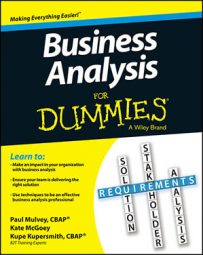On new development or mission-critical projects, several people may perform business analysis work. If so, business analysis planning may be divided among different business analysts. In these cases, the lead or senior BA should work with the sponsor, who has acquired funds to do the project and ensures project alignment with strategic goals.
If the project requires multiple business analysts, consider dividing business analysis work in any of these ways:
By subject matter expert (SME) or business unit.
By deliverable type. For example, a data analyst is responsible for the data, and a process analyst is responsible for the process.
By phase or iteration. For instance, if you have four phases and two BAs, figure out which phases are more complicated and assign your senior BA to those.
By pairing junior BAs with senior BAs.
On large projects, when multiple BAs are working together with a larger team, sharing resource schedules to create a realistic plan is critical. Keep these things in mind:
Use a small planning team (such as project manager, business analyst, business leader, and IT lead/architect) to determine the appropriate project methodology to follow.
Consider an incremental and iterative process such as RUP (where the project team performs risk analysis before each iteration and works on the portion of the system that has the highest risk) or an agile methodology, where the product is delivered in short iterations of 2 to 4 weeks.
Develop a communication plan with the project manager to minimize confusion (such as conflicting meetings or messages between the business analyst and the project manager).
Plan analysis tasks around strict time boxes (separate time periods — generally two to six weeks — that each have their own measurables). Doing so reduces analysis paralysis (getting caught up in overanalyzing every last detail without ever moving forward) and makes sure you clearly document what deliverables you’re delivering.
Think beyond typical analysis tasks like eliciting, analyzing, and communicating requirements. Plan for rigorous requirements-review activities, adequate user testing, and transition activities.

